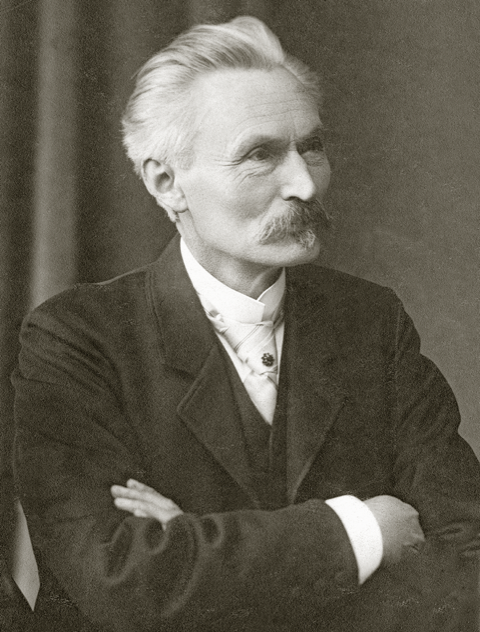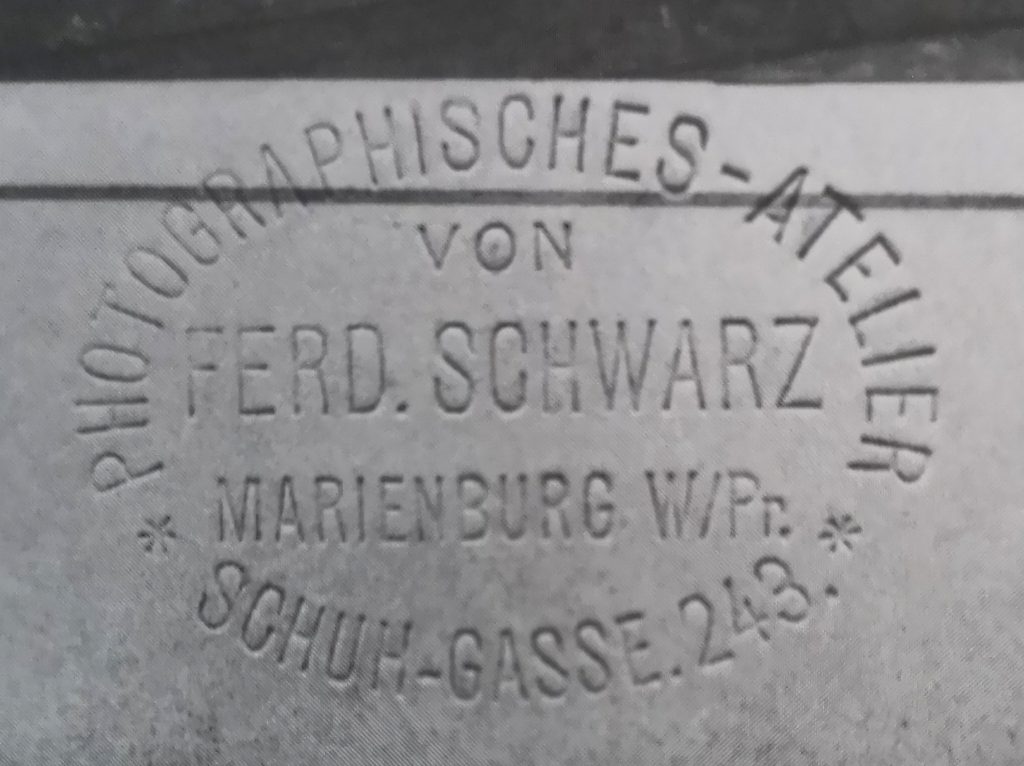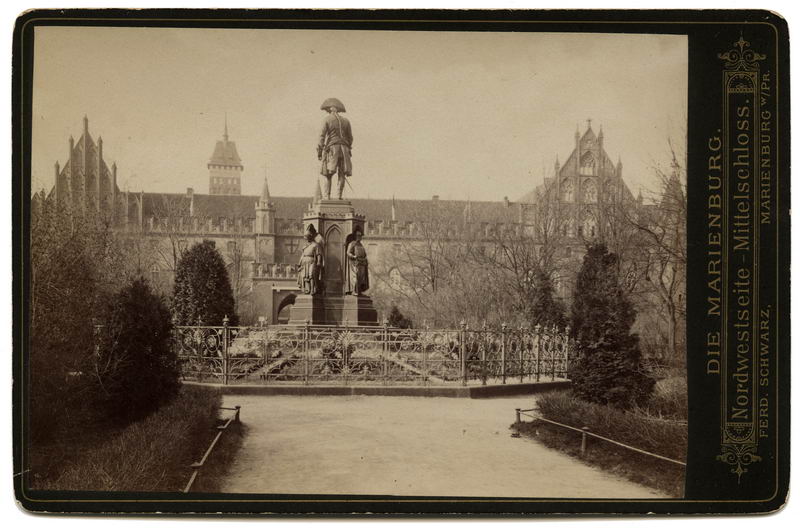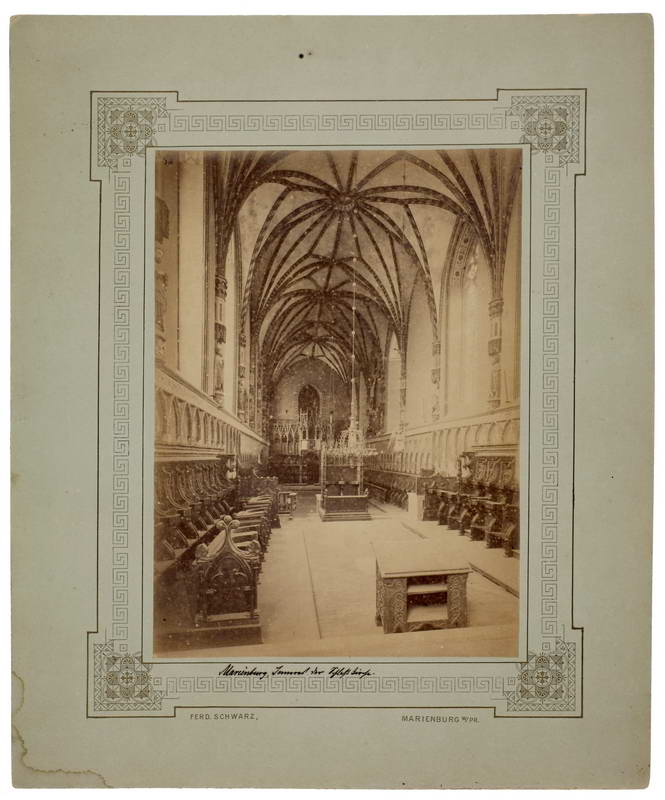Ferdinand Schwarz (December 8, 1852 Mechnica ‒1927) was one of the many photographers with whom the Malbork Castle Reconstruction Board cooperated the longest – for 17 years. In mid-October 1883, shortly after getting married to Augusta Wilhelmina née Steffen, he moved from Elbląg to Malbork. In the same year, he rented a house from the restaurateur Neumann at 243 Szewska Street (later No. 9). He set up a photographic atelier in an outbuilding called the garden house, which already stood on the grounds of the southern moat of the castle, right next to the old bridge, built back in the times when the castle was once Prussian barracks. One of the walls of this house was the retaining wall of the southern moat. The location of this house was the cause of a long (15 years) trial of Schwarz with the Castle Reconstruction Board, which he did not foresee when he purchased the entire property in 1899 from Neumann’s heirs. Embittered, he wrote the history of this process in the brochure “Wer das Glück hat, siegt, Bure oder Engländer. Geschichte meines Prozesses gegen den Schlossfiskus Marienburg ”published in 1907 in the publishing house of H. Stamm in Malbork. After 1907, he moved to Dzierzgoń where he continued his business. However, he stopped working with the Management in 1900. In the first years of his activity, he used the wet collodion technique and a little later he made photographs in the dry, bromo-gelatin technique. He was also the issuer of his own postcards.
In the years 1883-1900, when the cooperation with the conservator Conrad Steinbrecht and the Castle Reconstruction Board in Malbork was still successful, the photographer made a lot of glass negatives (9 × 12 cm), which, properly classified and secured in bound albums, made up the Library of the Photographic Archive. In addition, he provided a lot of photographic prints (9 × 12 cm, 13 × 18 cm) to the Malbork Annals of Castle Reconstruction (Marienburg Baujahren). Each year was usually made in nine copies, which were sent to William II, King of Prussia and Emperor of Germany and to all state institutions supervising and supporting the restoration work carried out in the castle. The copies intended for the emperor were bound in half-leathers with embossed gold letters and ornaments by the Berlin bookbinder W. Collin. In 1903, the above-mentioned photographic archive consisted of 700 glass negatives, but not all of them were made by Schwarz. What you can read about: https://straty.zamek.malbork.pl/albrecht-meydenbauer-1834-1921/ and https://straty.zamek.malbork.pl/zbior-negatywow-szklanych/
It is possible to indicate only three years (1888-1890), negatives and prints of which were made by Schwarz himself. The rest also featured works by other photographers. From 1891 to 1900 he collaborated with Carl Kuhnd, who after Schwarz left, took his place as a castle photographer: https://straty.zamek.malbork.pl/carl-kuhnd-1853-1921/
Schwarz worked in portrait and landscape photography. He also took stereoscopic photos. He published a series of postcards showing the beauty of the castle and the city, which were eagerly purchased by more and more tourists. He also recorded very important events for the city as well as for the closer and more distant surroundings. His photographic albums showing not only the castle in its full glory are very well known, e.g. the interior of the castle church after Conrad Steinbrecht’s restoration (Die Marienburg. Inneres der Schlosskirche, 1892), but also events such as the flood in Żuławy (Bilder von dem Nogat-Eisgang und der Ueberschwemung am Sonntag Palmarum den 23 | 3 1888), construction of a bridge – a new crossing over the Nogat (Neu Nogat Brücke bei Marienburg), or the fire of the city of Malbork in 1899 (Marienburg. Brand im Hohen Lauben 26 | 7 1899).
In 1912, Ferdinand Schwarz became a founding member of the photographers’ guild of the Elbląg district and deputy of the senior guild – Wilbald Zehr, which was a proof of recognition for his achievements. He received medals at the North German Craft Exhibition in Königsberg in 1885 (great silver), at the West Prussian Craft Exhibition in Grudziądz in 1886 (silver) and at the International Exhibition for Amateur Photographers in autumn 1896 in Berlin (gold). At the end of his life, he photographed the Sierakowski family from Waplewo.
Lit.: B. Pospieszna, Archiwum fotograficzne malborskiego zarządu odbudowy zamku (1882-1920) [w:] Praeterita Posteritati, Studia z historii sztuki i kultury ofiarowane Maciejowi Kilarskiemu, red. M. Mierzwiński, Malbork 2001, s. 359‒382; B. Pospieszna, Przedwojenne archiwum fotograficzne na zamku malborskim, [w:] Przywracanie historii. Losy malborskich zbiorów po II wojnie światowej: katalog wystawy w Muzeum Zamkowym w Malborku, red. A. Siuciak, Malbork 2015, s. 209‒219; A. Dobry, Pocztówki: katalog zbiorów Muzeum Zamkowego w Malborku, Malbork 2011 [kat. 432, 556, 581].
(oprac. dr B. Pospieszna)
F. Schwarz's photographs from the collection of the Castle Museum in Malbork.





